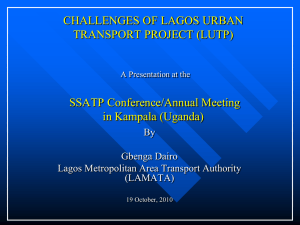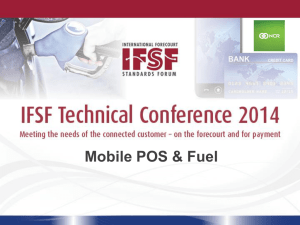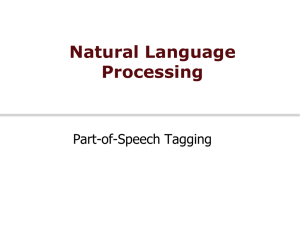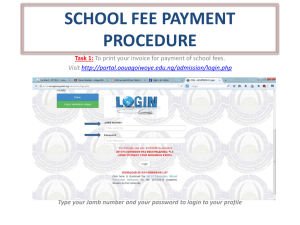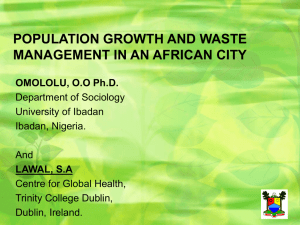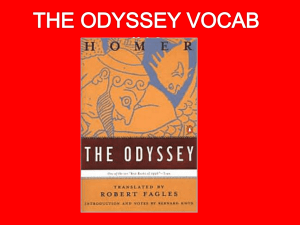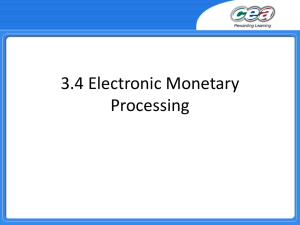Challenges / Perceived Obstacles to usage of PoS
advertisement
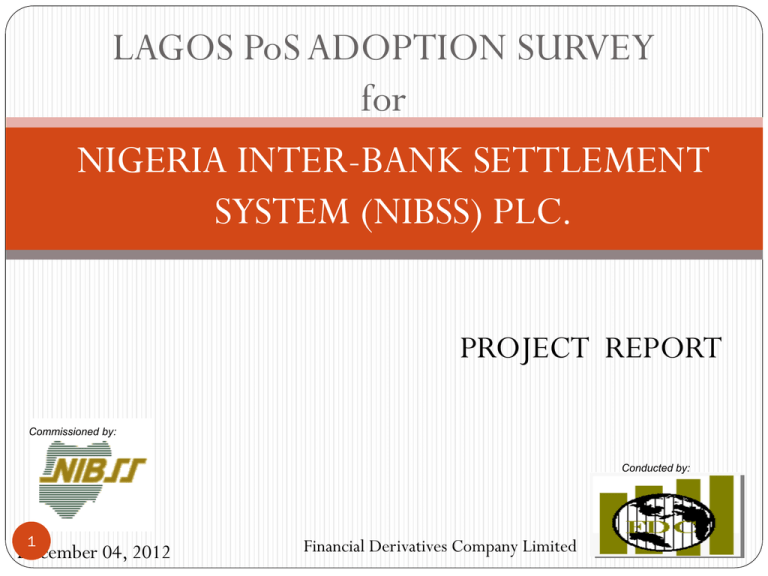
LAGOS PoS ADOPTION SURVEY
for
NIGERIA INTER-BANK SETTLEMENT
SYSTEM (NIBSS) PLC.
PROJECT REPORT
Commissioned by:
Conducted by:
1
December 04, 2012
Financial Derivatives Company Limited
Outline
Executive Summary
Background
Methodology
Survey Findings
Summary and Conclusion
Recommendations and Next Steps
2
Executive Summary
3
Executive Summary
NIBSS commissioned FDC in October 2012 to conduct a PoS
adoption survey in Lagos (Project NIBSS)
The project goal is to ascertain the level of adoption and/or
inhibitions to the widespread adoption of PoS terminals in Lagos
The project scope entails a market survey of both merchants and
end-users (cardholders) of PoS terminals in Lagos
Market survey conducted via administration of questionnaires in
four categories of market areas across Lagos
4
PoS Adoption Rate In Context
350
Deductions from
available data on total
number of PoS
terminals deployed and
volume of transactions
conducted indicates that
PoS terminals deployed
recorded an average of
46 transactions and a
maximum of 56
transactions per PoS
terminal monthly over
the period under
consideration
5
300
250
200
150
100
50
0
Jan-12 Feb-12
Vol. of PoS Transactions ('000)
No. of PoS Terminals ('000)
Source: NIBSS
2
31
25
51
Mar- Apr- MayAugOctJun-12 Jul-12
Sep-12
12
12
12
12
12
92
114 179 192 236 270 262 330
90
124 136 152 159 165 170 181
Research Objectives
Active profiles
Understand the profiles of merchants and end-users
Service attractiveness
Investigate the attractiveness of the PoS Terminals
Compare with other means of payment
Service weakness
Identify perceived obstacles with the use of the PoS Terminals
Identify solutions that will enhance the adoption, subscription
and effective utilisation of the card payment system
Geographical Dynamics
Understanding the dynamics and challenges in the use of PoS
Terminals, geographically
6
Results and Findings
7
Merchants with PoS
8
Merchants with PoS Terminals
According to the survey results,
of the 3,562 merchants with PoS
terminals
47% are general merchants
22.4% operate supermarkets
10.9% are pharmaceutical
stores/hospitals
7.3% are restaurants/eateries
12.4% are other forms of
businesses
These business types are mostly
located in open markets (39.5%)
Neighborhood shops constitute
29.5%
29.5% are in shopping malls
9
and 1.5% are kiosk locations
Business Type
12.4%
General Merchant(trader)
Pharmaceutical
Store/Hospitals
47.1%
22.4%
Restaurants/Eatery
Supermarket
7.3%
Others
10.9%
Business Location
1.5%
Open Market
28.5%
39.5%
Neighborhood
Shops
Shopping Malls
Kiosks
29.5%
Merchants with PoS Terminals
In spite of having PoS Terminals, avenue to EFT
and Cheques payment most Merchants still
accept cash above PoS
Accepted Payment Methods
100.0%
93.9%
90.0%
Cash payment was selected as the most accepted
mode of payment (93.9%)
73.2% of the merchants surveyed accepted
card payments
61.7% of these respondents accepted
cheques
25.5% accepted electronic fund transfers
(EFT) for payment, and 0.9% accept other
means of payment
80.0%
73.2%
70.0%
61.7%
60.0%
50.0%
40.0%
Investigation on why they accept cash over card
payment while they have the PoS Terminals show
that:
PoS deployment was involuntary as they were
deployed by banks unsolicited
PoS deployment is not PoS availability for usage as
some keep it under their lockers
Delays associated with access to funds after sales
10
from the PoS
30.0%
25.5%
20.0%
10.0%
0.9%
0.0%
Cash
Cheques
Cards
EFT
others
Merchants with PoS Terminals
Preferred Payment Methods
2.5% 1.3%
method of payment
9.1% rating for cheques
11.5% for cards
2.5% for EFTs
1.3% for other means of payments
9.1%
75.5%
11
Cheques
By preference
75.5% of merchants prefer cash as the
11.5%
Cash
Accepted Payment Methods
Cards
EFT
others
Merchants with PoS Terminals
For the non-cash options,
47% of merchants prefer
the card payment scheme to
other payment schemes.
On the available card types
40.7% of merchants prefer
the Master Card
VISA is the next preferred
card payment type with
31.9% of the responses
followed by Verve with
27.4% of the responses.
50.0%
47.0%
45.0%
40.0%
37.2%
35.0%
30.0%
25.0%
Series1
20.0%
15.0%
10.4%
10.0%
5.4%
5.0%
0.0%
Cheques
Verve
VISA
Master Card
12
Cards
EFT
27.4%
31.9%
40.7%
others
Merchants with PoS Terminals
A total of 24.4% of
13
Card Payment Success Rate
merchants indicated
that the success rate
of cards is less than
25%
29.8% of merchants
believe the success
rate to be between
25% and 55%.
29.6% claimed that
success rate was
between 55% and
75%
35.0%
16.2% of the merchants
5.0%
indicated that the success
rate of card payment was
above 75%
29.8%
30.0%
25.0%
29.6%
24.4%
20.0%
16.2%
15.0%
10.0%
0.0%
Less than 25%
Between 25% and 55%Between 55% and 75%
Above 75%
Recommendation – Merchants With PoS Terminals
Based on the findings above, our recommendations are as follows:
Periodic checks should be carried out by the Payments Terminal Service
Providers (PTSPs) in order to ascertain the condition of the PoS Terminals
and get feedback about the functionality of PoS Terminals
The PTSPs’ technician contact number should be made available to
merchants, so that they can receive quick/first hand technical assistance
when they need it
The role of the NIBSS certification laboratory/facility to
certify/approve PoS Terminal models should be popularised and
communicated to merchants to boost confidence in the system and
regulate PoS Terminals in circulation
PoS Terminal certifying agency should conduct periodic spot-checks of
14
PoS Terminals with merchants.
Recommendation – Merchants With PoS Terminals
There should be partnership among banks, mobile payments
operators, all other existing payment schemes and other support
service providers to foster high availability and adoption of PoS
Terminals, with the goals of:
Mitigating current network connectivity problems
Delays in accessing proceed of sales
A fair transaction charge should be agreed upon among banks,
which should be communicated to the merchants, as:
Some merchants in certain locations are price-sensitive
15
Merchants Without PoS
16
Merchants Without PoS
Business Type
From the surveyed 1,627
merchants without PoS
57.5% of them are general
merchants
16.4% operate supermarkets
8.2% run restaurants/
eateries.
17.9%
General Merchants
Operate Supermarkets
8.2%
Restaurants and Eateries
57.5%
16.4%
In terms of location, 49% are
in open markets
1.9
21.3
26.9% are in neighborhood
shops
21.1% are in shopping malls
1.8% are kiosks.
17
Other Business Type
Open Market
49.6
Neighborhood Shops
Shopping Nalls
Kioks
27.2
Merchants Without PoS
Accepted Payment Methods
Cash payment was selected as the
most accepted mode of payment
(65.8%)
24.3% accept cheques
7.9% accept EFTs
2.0% accept other means of
2.0%
7.9%
payments such as bank deposits
This establishes the expectation of
24.3%
65.8%
Cash
18
Cheques
EFT
Others
high preference for cash by
merchants without PoS terminals.
To engender the imperative of the
Cash-Less Lagos project, this
should not be accepted as a do
nothing case. Bankers to these
merchants need to introduce PoS
Terminals to them and adopt more
friendly criteria for PoS Terminal
deployments
Merchants Without PoS
Reasons for not having PoS
Reasons alluded for not
having PoS Terminals in
descending order are:
30.2%
27.7%
26.6%
Fear of default and fraud -
30.2%
Easy access to cash – 27.7%
Bank refusal to deploy –
26.6%
Customer’s insistence to use
cash – 25.7%
Technical malfunctioning –
21.6%
PoS Deployment/Transaction
fee – 20.0%
Connectivity – 18.1%
19
23.7%
21.6%
20.0%
18.1%
Merchants Without PoS
70.0% of the merchants expressed willingness to accept PoS
Terminal mode of payments.
Interest in Accepting PoS Terminals for Payment
30.00%
70.00%
20
Recommendation – Merchants Without PoS
Terminals
We make the following suggestions based on our finding above:
Banks need to revise the criteria for PoS Terminal deployment in
21
such a way as to encourage Merchants without PoS Terminals
A massive awareness program should be undertaken to publicize the
purpose and benefits of the PoS system and allay fears of
default/fraud in the following ways:
Publicity through radio and direct contact
Focus on high and medium density areas (e.g. Oke-Arin,
Nnamdi Azikiwe markets) because less sophisticated merchants
are located in this areas.
Publicity in more sophisticated areas (e.g. Ikoyi, Victoria Island)
should emphasize direct contact with the merchants and/or
formal letters of introduction.
Other publicity means to be explored like bill boards, fliers, social
Recommendation – Merchants Without PoS
Terminals
PTSPs to be encouraged to accept frontal roles in PoS deployment in
line with approved guidelines
Training on the usage of PoS Terminals immediately after deployments
PTSPs should check on the merchants after a few days of training in order
to ensure that merchants understand how to use the PoS Terminals and are
using them appropriately
The same procedures mentioned under the ‘merchants with PoS’
section should be followed in order to ensure network problems and
technical faults are addressed promptly
The fear of frauds would be resolved once the PoS Terminals are
functioning properly because trust in the PoS system would have been
built
22
Consumers/End-Users
23
Consumers/End-Users
Consumers With Cards
Of the 1,587 consumers/end-users surveyed,
Current and savings account holders
constituted 31.5% and 32.2% of responses
from high-density (HD) areas
34% and 34.5% from medium-density (MD)
areas
34.6% and 33.3% from low-density (LD)
areas respectively
Card holders constitute 82.4% of total responses
while 17.6% do not own cards
Despite the high ownership of cards, cash was
still highlighted as the most used means of
payment across the density areas (88.5% - HD,
93.9% -MD, 87.7% - LD)
82.4%
The reasons highlighted by the consumers for
24
their continuous use of cash include
connection and network difficulties of the PoS
Terminals
delay in transaction time
fear of fraud amongst others
17.6%
Card Holders
Non Card Holders
Consumers/End-Users
Comfortable Payment Locations
We also identified the closeness of
banks and ATMs’ to both merchants
and consumers as a major inhibition
to PoS Terminal adoption
Despite the inhibitors, the
respondents indicated that they feel
most comfortable using the PoS and
card payment systems where available
and secure. This explains comfort to
use cards in supermarkets than in the
open markets
17.8%
15.0%
17.0%
24.8%
11.5%
13.9%
General Merchants
Restaurants / eatery
Malls
Supermarket
Pharmaceutical store / Hospitals
Others
Supermarkets (24.8%), malls
(17.0%), general merchants’ stores
(15.0%), pharmaceutical stores and
hospitals (11.5%), others (17.8%)
73% of consumers indicated they
25
would encourage others to use the
PoS and card payment systems based
on their experience with the payment
systems so far
Encouraging Others based on Experience
73.00%
27.00%
Encourage Others
Indifferent/Would not
encourage others
Recommendations – Consumers/End-Users
Based on our findings above, our suggestions are as follows:
A massive awareness program to publicize the purpose and benefits of
the PoS system (similar to that recommended for merchants without
PoS)
Publicity through radio, bill boards, fliers, social media and TV adverts
Town storms and road shows are recommended to fast track end-users adoption
Ensure transparency in the PoS system process
All transaction costs and other issues associated with PoS Terminal usage should be
made known to consumers during the publicity program
Necessary steps to ensure that the PoS Terminals are working as expected should
be publicized to build trust
26
Recommendations – CONSUMERS/END-USERS
Carrying cash by consumers should be made less attractive through
policy formulation
The cash withdrawal limit by individuals should be revised downward
with more stringent charges for withdrawals above specified limits
The cash deposit limits for corporate account holders should be
reduced and the penalty for large deposits should be increased
27
Conclusion
The potential for growth of the usage of PoS Terminal in Lagos
metropolis remains strong.
With a population of over 16 million people, there are presently
approximately 8 million card holders in Lagos State
Based on the aggregated data from the 6,776 survey sample, the
study found out the following:
Challenges / Perceived Obstacles to usage of PoS
Terminals
Two out of the three categories of respondents (i.e. Merchants
with PoS and Merchants without PoS Terminals) identify
basically the same challenges and perceived obstacles to the
smooth operation of the PoS Terminals
28
Conclusion
The obstacles in order of priority are as follows:
Connectivity and network challenges
Transaction charges/charges to bank account
Consumers/merchants insistence to pay cash
Rejected transactions
Card reading/technical difficulties
Consumers/merchant lack of card/pos
Access to after sales funds
Others
Poor awareness of the PoS payment systems and benefits
Long transaction time/late transaction notification
29
24.5%
18.9%
12.7%
11.8%
11.3%
10.1%
6.6%
4.3%
Conclusion
Challenges that deter consumers from making use
of the pos terminals
According to priority, factors that inhibit consumers’ usage of
the card payment system include:
Connection and network difficulties with the terminals
Non-Availability of PoS Terminals at merchants’ points/stores
Attributed to the poor rate of deployment as noticed by
the Merchants with PoS
Merchants demand for cash
As a result of obstacles listed above
30
Conclusion
Long/delayed transaction time
Fear of fraud
Some consumers gave personal experiences on being debited
twice
In some cases the terminals reject the transaction, however the
consumer receives a debit alert some hours after the
unsuccessful transaction
31
Next Steps
32
Next Steps
We suggest a follow-up integration survey in Lagos State most
importantly in the areas not covered by this survey
This will help to further identify other cultural and fundamental
barriers to the adoption of the PoS Terminals
Popularisation of NIBSS role as PoS Terminal certification agency and
regular spot checks of PoS Terminals in use at merchant points
There is need for a pilot survey in other key cities where the Cashless policy will be introduced before implementation
This will help to identify the necessary pre-implementation
steps to be taken; identify the trend and compare results with
the Lagos density areas
This will help underscore the model to be adopted for each
of the new locations
33
Background & Methodology
34
Background and Methodology
The “Project NIBSS” entails a market survey of both merchants and
end-users (cardholders) of PoS terminals in Lagos
Market survey conducted via administration of questionnaires in
four categories of market areas across Lagos
Stratification of sample area (Lagos State) into
Lagos
Yaba
Ikeja
Badagry
Further stratification into high, medium and low density areas
35
Background and Methodology
Spot Check on enumerators during enumeration
By both FDC and NIBSS team
Project update presented during the course of the survey
Feedback from update incorporated
36
Scope of Survey
FIELDWORK SETUP
High Density Areas
Medium Density Areas
LAGOS
Yaba
37
Oke-Arin/Ereko/Idumota
Balogun
Nnamdi Azikiwe
Yaba/Alagomeji/Sabo/
Ebutemeta
IKEJA
Ikeja/Computer
Village/Alade/Opebi
Ketu/Ikosi/Magodo
BADAGRY
Alaba
Trade-Fair
Low Density Areas
Ajah/Ikota
V.I./Ikoyi/Lekki
Surulere/Bode
Thomas/Lawanson,
Mushin
Ogba
Gbagada
Maryland
Iponri
Festac/Amuwo Odofin
Satellite Town
Apapa
Badagry
Egbeda
Ilupeju
Agege
Scope of Survey
Location
Merchant With POS
Target
Actual
Merchant
Without POS
End-Users
Target
Actual
Target
Actual
High Density Areas
1,500
1,982
500
511
500
521
Medium Density Areas
1,000
836
500
413
500
511
Low Density Areas
1,000
744
500
703
500
555
Total
3,500
3,562
1,500
1,627
1,500 1,587
7, 000 questionnaires were administered
6776 were successfully filled and analysed
Covering merchants with PoS, merchants without PoS
and end-users ( Card and Non-card holders)
38
Drawbacks
Drawbacks included
Several duplication of addresses of merchants with PoS
Incorrect addresses of merchants with PoS
Difficulty in meeting owners and managers where sales
personnel's/other staff insist they cannot fill the
questionnaires
Some questionnaires administered were not returned as a
result of merchants insistence on enumerators picking them
up later
Respondents fear of confidentiality
Angry respondents (basically as a result of their bad
experiences with PoS terminal)
39
Survey Findings -Quantitative
Merchants with PoS
40
Respondents Status in Relation to
Business
41
50.0%
45.4%
Respondents Status in Relation to Business
45.0%
40.5%
40.0%
32.4%
35.0%
27.9%
30.0%
25.0%
20.0%
15.0%
21.1%
20.0%
17.5%
20.8%
16.7%
15.7%
16.5%
21.0%
20.7%
17.8%
15.0%
14.7%
12.7%
11.6%
7.6%
10.0%
3.8%
5.0%
0.5%
0.0%
0.0% 0.0%
0.0%
Owner
Partner
Manager
Others
Sales Representatives
High Density
Badagry
Ikeja
Lagos
Yaba
Responses from Survey shows
More business owners (45.43% -Yaba) responded to the questionnaires
21.1% in Ikeja were by managers
20.7% were by secretaries and personal assistants in Badagry
40.5% were other staff and workers in the various outlets
42
20.8% - Ikeja, 16.5% in Badagry and 11.6% in Lagos
Secretary/P.A
Respondent Status in Relation to Business
38.5%
61.7%
35.1%
46.7%
25.0%
25.0%
25.0%
25.0%
30.0%
24.0%
12.8%
24.0%
6.8%
4.1%
0.0%
2.7%
0.0%
Medium Density
Badagry
Ikeja
Lagos
Low Density
Yaba
Equal number (25%) of respondents from the
Ikeja, Badagry and Lagos zones are Owners,
Managers, Partners and Sales representatives
However, a majority (38.5%) of the
respondents in the Yaba medium density area
43 were Owners
Badagry
Ikeja
Lagos
Yaba
A greater proportion of the respondents in
Yaba (46.7%) and Ikeja (24.0%) are Owners
Majority of the respondents in Badagry
(24.0%) and Lagos (61.7%) zones are
Managers
Sales representatives were 30% in the Lagos
area
Nature of Business
44
35.6%
Most of the respondents in the Lagos
28.4%
10.2%
17.5%
16.9%
13.0%
9.3%
5.8%
2.6% 2.6% 0.5% 3.6%
0.0% 0.0%
Others
Churches/Mosques
Cinemas
Barbershop/Hairdressing Salon
Pharmaceutical Store/Hospitals
Restaurants/Eatery
Supermarket
General Merchant(trader)
High Density
Ikeja
Lagos
In the Ikeja zone, 32.1% were owners of
other kind of businesses
20% of respondents in the Badagry area
were general merchants, own restaurants,
supermarkets, pharmaceutical stores and
hairdressing salons each
43.9%
32.1%
31.8%
Yaba
1.5%
5.4%
Others
Yaba
Churches/Mosques
Medium Density
Badagry
Ikeja
Lagos
19.7%
Cinemas
In the Badagry and Ikeja zones 20.2% and 20%
own restaurants.
Barbershop/Hairdressing Salon
Pharmaceutical Store/Hospitals
Most respondents in Lagos (37.7%) own
supermarkets
Restaurants/Eatery
Supermarket
35.6% (the majority) of the respondents in the
Yaba high density areas were General merchants
(traders)
25.8%
23.6%
20.0% 20.0%
20.0% 20.0%
20.0%
12.7% 12.1% 12.6%
12.4%
9.1% 10.6%
8.1%
1.5%
General Merchant(trader)
45
(31.8%) and Yaba (43.9%) medium
density areas were general merchants
20.2%
18.7%
46.7%
35.0%
24.7%
21.7%
19.4%
19.7%
20.0%
19.6%
15.4%
Badagry
Ikeja
Lagos
Yaba
46.7% and 24.7% of respondents were general merchants and
46
supermarkets respectively in the Yaba area
In the Ikeja zone,19.6% own barber shops/hairdressing salons
35% of Lagos respondents were mostly owners of other kind of
businesses
Others
Churches/Mosques
Cinemas
Barbershop/Hairdressing Salon
Pharmaceutical Store/Hospitals
Restaurants/Eatery
Supermarket
General Merchant(trader)
Low Density
Nature of Business and Business Location
47
General merchant stores (18.1%),
SM
Others
Kiosks
Churches/Mosques
NS
Cinemas
OM
Others
48
Churches/Mosques
Cinemas
Barbershop/Hairdressing Salon
Pharmaceutical Store/Hospitals
Restaurants/Eatery
Supermarket
General Merchant(trader)
High Density
1.3%
Barbershop/Hairdressing Salon
1.8%
Pharmaceutical Store/Hospitals
3.4% 2.4%
Restaurants/Eatery
7.2%
3.7%
2.6%
Supermarket
12.8%
10.9%
7.1%
General Merchant(trader)
supermarkets (7.2%), and restaurants
(5.7%) were located in the open market,
shopping malls, and kiosks respectively.
However, a majority of pharmaceutical
stores (3.4%) and hair dressing salons
(2.4%) were located in neighborhood
18.1%
shops.
14.4%
12.5%
Medium Density
OM
NS
Kiosks
SM
General merchant stores (14.4%) and
pharmaceutical stores (2.6%) were located in
the open market
Supermarkets (7.1%), restaurants (3.7%) and
hair dressing salons (1.3%) were located in
kiosks, shopping malls and neighborhood shops
respectively.
Like other density
8.2%
6.2%
6.1%
5.9%
4.3%
2.2%
4.6%
4.1%
3.6%
2.7%
3.1% 2.4%
1.5%
.6%
.0%
SM
Others
Kiosks
Churches/Mosques
NS
Cinemas
OM
Barbershop/Hairdressing Salon
Pharmaceutical Store/Hospitals
Restaurants/Eatery
Supermarket
49
10.8%
General Merchant(trader)
areas, a majority
(13.5%) of general
merchants were located
in open markets
Supermarkets (6.1%)
and pharmaceutical
stores (3.1%) were
located in shopping
malls
Majority of restaurants
(4.1%) and hair
dressing salons (2.4%)
were located in
neighborhood shops.
13.5%
Nature of Business and Proximity to
Banks and ATMs
50
9.9%
8.7%
7.5%
39.1% of total responses are merchants between
9.0%
8.3%
8.1%
7.6% 7.8%
2 to 5 minutes from banks and ATMs’.
14.7% of them are located in shopping
6.3%
2.4%
2.1%
.5%
Very
near(less
than 2
minutes
distance)
malls
4.7%
4.6%
4.6%
4.1%
Near(2 to 5
minutes
distance)
OM
27.3% of total respondents noted that their
2.5%
.9%
.4%
.0%
Distant(6 to
Much
Do not know
15 minutes distant(more
distance)
than 15
minutes)
High Density
NS
Kiosks
stores and outlet are between 6 to 15 minutes
walking distance from banks and ATMs
11.5% of them are located in open
markets
14.5%
14.7%
12.3%
11.1%
SM
11.5%
Most (9.9%) of merchants in open markets are 2
7.7%
7.1%
and 5 minutes walk from banks and ATMs
An average of 30% of the merchants take
between 6 to 15 minutes to get to banks
and ATMs
8.7% of total responses are merchants in
shopping malls and are located less than 2
minutes away from banks and ATMs (24.9% 51less than 2 minutes)
3.1%
1.9%
1.7%
Very
near(less than
2 minutes
distance)
3.9%
3.1%
2.4% 2.2%
1.0%
1.0%
Near(2 to 5
minutes
distance)
Distant(6 to
15 minutes
distance)
Medium Density
OM
NS
.2%
.4%
Much
Do not know
distant(more
than 15
minutes)
Kiosks
SM
36.9%
of the responses take
between 6 to 15minutes, while
36.4% of merchants take 2 to 5
minutes to get to banks and ATMs
12.8% of those with 6 to
15minutes are located in
Kiosk
12.% of those with 2 to
5minutes are located in open
markets
18.7% noted that their stores and
outlet are less than 2 minutes
walking distance from banks and
ATMs
6.2% of them are located in
open markets
12.9%
12.8%
9.6%
9.1%
9.3%
8.2%
6.6%
6.2%
4.9%
4.8%
4.0%
3.6%
3.0%
2.1%
1.0% 1.1%
.4% .1%.3%
.0%
Very near(less
than 2 minutes
distance)
Near(2 to 5
minutes
distance)
Distant(6 to 15
minutes
distance)
Much
distant(more
than 15
minutes)
LowDensity
OM
52
NS
Kiosks
SM
Do not know
Accepted Means of Payment
53
40.75%
39.54%
37.52%
37.24%
Accepted Means of Payment
40.05%
32.22%
30.32%
24.61%
22.78%
19.03%
24.37%
13.82%
13.36%
11.18%
7.21%
5.15%
0.31%
0.28%
0.23%
0.05%
High Density
Badagry
Ikeja
Lagos
Yaba
Majority of the respondents in the high density areas accept cash
Lagos-39.54%, Ikeja-37.52% Badagry-37.24% and Yaba-40.75%
Debit/credit cards was next to cash in the Ikeja-32.22% Badagry-30.32% and Yaba-40.05%
Next to cash in Lagos was Cheque (24.61%)
54
40.28% Means of Payment
Accepted
37.04%
40.28% 38.89%
33.19% 32.47%
30.95%
28.25%
25.18% 25.97%
22.22%
13.89%
12.01%
7.94%
4.48%
4.17%
1.39%
0.12% 1.30%
Medium Density
Badagry
55
Ikeja
Lagos
Yaba
Respondents in the Lagos (38.89%) and Yaba (32.47%) medium density areas accept cash.
In Ikeja (37.04%) preferred debit/credit cards
Equal number (40.28%) of respondents in the Badagry area accept cash and debit/credit cards
38.06%
37.65%
35.31%
Accepted Means of Payment
37.65%
35.32%
34.99%
30.81%
27.53%
24.24%
18.84%
18.79%
15.88%
17.17%
10.86%
8.82%
7.53%
0.30%
0.25%
0.00%
0.00%
Low Density
Badagry
Ikeja
Lagos
Yaba
In the low density areas, majority of the respondents accept cash (Ikeja-38.06%, Badagry- 35.31%, and
Yaba- 30.81%)
Equal number (37.65%) of respondents in the Lagos zone accept cash and debit/credit cards.
56
Frequency of Usage
57
High Density
95.4%
92.9%
90.0%
85.1%
59.9%
19.8%
14.7%
5.8%
3.8%
0.6%
Cash
Cheque
10.9%
7.2%
3.3%
17.4%
14.7%
11.1%
4.4%
EFT
38.6%
35.8%
31.2%
29.7%
24.5%
19.8%
0.3%
0.3%
0.5%
0.5%
Cards
Cheque
Many times per day
In all the high density areas, cash is
used many times a day
Lagos- 85.1%
Ikeja- 90%
Badagry- 92.9%
58 Yaba- 95.4%
EFT
Never
Badagry
Ikeja
Lagos
34.7%
12.9%
11.0%
Cash
37.3%
Yaba
EFT was never used
Lagos- 35.8%
Ikeja- 38.6%
Badagry- 31.2%
Yaba - 59.9%
Cards
Medium Density
96.5%
89.7%
80.0%
80.0%
68.9%
65.2%
50.0%
34.8%
34.2%
31.9%
25.4%
21.1%
18.8%
1.2%
Cash
Cheque
4.3%
1.0%
EFT
Medium Density
Many times per day
17.6%
14.1%
12.5%
12.0%
25.0%
3.3%
0.0%
0.0%
Cards
Cash
Cheque
EFT
Cards
Never
Badagry
Ikeja
Like the high density areas, cash was used
many times a day in the medium density areas
Lagos- 65.2%,
Ikeja-80%
Badagry-89.7%
59
Yaba-96.5%
Lagos
Yaba
Electronic funds transfer was never used
Lagos- 34.8%
Ikeja - 68.9%
Badagry (80%)
Yaba- 34.2%
Low Density
96.9%
91.3%90.8%
60.4%
56.8%
45.3%
38.0%
36.2%
25.0%
12.3%
6.5% 5.8%
Cash
Cheque
28.0%
26.5%
16.9%
6.6%
2.7%
0.5%
EFT
23.3%
17.7%
12.5%
4.6%
20.6%
13.8%
11.1%
0.7%
Cards
Cash
Cheque
Many times per day
EFT
Cards
Never
Badagry
Ikeja
Lagos
Yaba
In the low density areas, cash was used many
Cheques were never used in Badagry (36.2%)
times per day
Lagos- 60.4%
Ikeja-91.3%,
Badagry-96.9%
60
Yaba-90.8%
Electronic funds transfer was never used
Ikeja -38%
Yaba -56.8%
Badagry -45.3%
Preferred Card Scheme
61
42.9%
38.5%
38.9%
38.1%
36.7%
36.1%
30.6%
29.4%
32.0%
29.9% 31.7%
30.0%
23.7% 22.2%
23.6%
22.4%
20.9%
27.8%
18.4%
16.7%
17.1% 17.8%
17.7%
33.3%
33.3%
31.0%
26.9%
23.8%
20.4%
19.0%
30.4%
AMEX
20.9%
19.4%
17.7%
17.6%
17.9%
VISA
eTRANSACT
Loyalty
Mastercard
Verve
Others
0.0%
High Density
0.0%
Low Density
Medium Density
Majority of the respondents in the Badagry (38.1%), Ikeja (30.6%) and Yaba (29.4%) high density
areas preferred the MasterCard
VISA card was preferred in Lagos (22.2%)
The second choice in the Badagry (30%) and Ikeja (23.7%) zones was the VISA card
62
MasterCard and Verve were the second best in the Lagos (20.9%) and Yaba (17.8%) zones
respectively
Preferred Card Scheme
A greater proportion of the respondents in the medium density areas preferred the
MasterCard
Lagos-38.5%
Ikeja -36.7%
Yaba-30.4%
VISA and MasterCard are equally preferred by majority (33.3%) of the respondents in
the Badagry area
VISA card is the second best in Ikeja (26.9%), Lagos (17.9%) and Yaba (19.4%)
Verve card was the second best in Badagry (31%)
In the low density areas, the MasterCard was the preferred card scheme
Badagry-36.1%
Ikeja-42.9%
Yaba-23.8%
Verve card was the preferred card in Lagos constituting 38.9%
The second best in the low density areas were as follows:
Lagos- MasterCard (27.8%)
Ikeja- VISA (31.7%)
Badagry-verve (32%)
Yaba- VISA (20.4%)
63
PoS Usage Motivation
64
16.06%
16.03%
14.23%
14.14%
14.17%
15.91%
14.25%
14.55%
15.73%
14.13%
14.47%
15.46%
14.59%
14.01%
15.38%
13.20%
14.37%
15.57%
14.84%
14.48%
14.44%
13.87%
14.12%
15.44%
13.02%
13.36%
14.14%
6.07%
Additional
Payment Method
Simplicity of
usage(vs. cash)
High costs of cash
management
To avoid
robberies and
theft
Image of the
outlet
Faster payment
processing time
Other
High Density
Badagry
Ikeja
Lagos
Yaba
Majority of the respondents in the Ikeja (16.06%) and Yaba (14.55%) zones acknowledged that
the main motivation for adopting the PoS was the simplicity of its usage.
Majority in the Lagos (15.46%) zone adopted the PoS due to high costs of cash
65
management
Badagry (15.57%) zone adopted the PoS based on other reasons
15.1%
14.2%
13.4%
14.9%
14.8%
13.8%
15.7%
14.5%
14.7%
13.7% 13.6%
15.9%
15.5% 15.9%
16.1%
15.0%
14.5%
15.9%
11.2% 11.0%
10.6%
Additional
Payment Method
Simplicity of
usage(vs. cash)
High costs of cash
management
To avoid
robberies and
theft
Image of the
outlet
Faster payment
processing time
Other
Medium Density
Badagry
Ikeja
Lagos
Yaba
A greater proportion of the respondents in the medium density areas adopted the PoS due to faster
payment processing time, image of the outlet, and high costs of cash management respectively
Yaba (16.1%), Lagos (15.9%) and Ikeja (15.7%)
66
20.00%
20.00%
16.49%
15.49%
16.10%
14.39%
15.04%
20.00%
17.43%
16.64%
16.54%
15.51%
16.62%
14.25%
14.13%
11.23%
10.00%
14.50%14.16%
13.03%
10.00%
14.48%
14.17%
13.55%
10.00%
10.00%
8.63%
7.61%
Additional
Payment Method
Simplicity of
usage(vs. cash)
Badagry
High costs of cash
management
Ikeja
To avoid
robberies and
theft
Low Density
Image of the
outlet
Lagos
Faster payment
processing time
Other
Yaba
In the low density areas, the majority of the respondents in Badagry (17.43%), Ikeja
67
(16.62%) and Yaba (15.04%) zones acknowledged that the main motivation for adopting
the PoS was low transaction time, high costs of cash management, and need for an
additional payment method respectively
An equal number (20%) of respondents in the Lagos low density area adopted the PoS
due to high costs of cash management, faster processing time and to have an additional
payment method
Perceived Inhibitions to PoS Usage
68
High Density
37.9%
Majority of the respondents in
34.4%
34.0%
33.0%
30.8%
26.5%
25.5% 25.4%
24.7%
20.9%
19.5%
14.6%
11.7%
9.6%
8.7%
6.7%
7.8%
5.9%
4.6%
4.3%
3.2%
2.8%
2.4% 2.2%
1.9%
1.1%
0.0%
0.0%
Badagry
Ikeja
Lagos
Yaba
Access to funds
Transaction Charges
Technical/Terminal Faults
Network/Connectivity
Payment Ease
Training on Usage
Easy Deployment
69
the Badagry (33%), Ikeja
(34.4%) and Lagos (30.8%) high
density areas, believe that
network/connectivity problems
are the inhibitions to the usage
of PoS terminals
37.9% in Yaba believe high
transaction charges discourage
people from using PoS
The second highest perceived
inhibition to PoS usage in Ikeja
(25.5%) and Lagos (26.5%) was
PoS technical faults
Badagry (25.4%) and Yaba (34%)
zones believe it was transaction
charges and network problems
respectively
Medium Density
Like the high density areas, 75% of the
respondents Badagry, 30.6% in Lagos
and 35.3% in Ikeja medium density
areas believe that
network/connectivity problems may
prevent people from using the PoS
35.1% in Yaba believed that transaction
charges was the main problem.
The second highest perceived
inhibition to PoS usage in Ikeja
(27.7%) and Badagry (25%) is PoS
technical faults
In Yaba (18.6%), delay in access to
35.1%
27.7%
27.4%
25.0%
27.4% 26.9%
17.5%
14.4%
0.0%
Yaba
0.0%
Access to funds
Lagos
Transaction Charges
Ikeja
Technical/Terminal Faults
Network/Connectivity
Payment Ease
Badagry
18.6%
9.7%
6.5%
7.2%
2.1%
5.2%
3.2%
1.6% 1.1%
1.9%
0.5% 0.0%
0.0%
0.0%
0.0%
Training on Usage
70
35.3%
30.6%
Easy Deployment
funds is the second highest.
An equal number (27.4%) of
respondents in the Lagos believe that
the second highest inhibition to PoS
usage was the high transaction charges
and technical faults
75.0%
Low Density
66.7%
In all the low density areas,
network/connectivity
problems discouraged their
usage of PoS terminals
38.2%
35.6%
Lagos-66.7%, Ikeja-29.9%,
29.9% 28.7%
28.2%
24.8%
25.0%
15.7%
13.4%13.0%
10.0%
8.3%
6.2%
4.5%
12.7%
10.8%10.2%
3.6%2.8%
3.3%4.0%2.5%
1.9%
0.0%
0.0%
0.0%
Yaba
Access to funds
Lagos
Transaction Charges
Ikeja
Technical/Terminal Faults
Badagry
0.0%
Network/Connectivity
Payment Ease
Training on Usage
Easy Deployment
71
Badagry-38.2% and Yaba35.6%
Technical faults are
perceived to be the second
highest inhibition to PoS
usage in all the zones
Lagos-25%, Ikeja-24.8%,
Badagry-28.7% and Yaba28.2%
Inhibitions to PoS Usage Based on
Experience
72
22.9%
22.3%
19.9% 20.2% 20.0%
20.4%
15.8%
9.7%
11.3%11.6%
10.6%
6.1%
6.6%
19.6%
19.6%
15.3%
14.2%
11.9%
14.6%
9.5% 9.1%
8.3%
8.3%
7.2%
5.2%
0.0%
High Density
Customers' do not have cards
Connectivity problems
Card reading difficulties
Low Density
Transaction charges
Easy access to cash
Other
19.0%
16.9%
15.3% 15.6%
10.7%
9.1%
7.5%
6.9%
4.1%
1.8%
Medium Density
Customers insistence to pay by cash
Transactions are often rejected
Transaction charges were found to be the inhibitions to PoS usage by 20.2% of the respondents in Ikeja and
20% in Lagos high density area
In Badagry (22.3%) and Yaba (20.4%), the majority of the respondents chose connectivity problems and
‘transactions are often rejected’ as the main inhibitions to PoS usage
73
A greater proportion of the
respondents in the Ikeja (19.6%)
and Lagos (16.9%) medium
density areas chose transaction
charges as the inhibition to PoS
usage
19.7% in Yaba and 19.6% in
Badagry zones chose ‘customers
insist to pay by cash’ and
‘transactions are often rejected’
74
In the Badagry (14.6%),
Ikeja (22.9%) and Yaba
(15.3%) low density areas,
transaction charges were the
main inhibitions to PoS usage
Equal percentage (8.3%) of
respondents in Lagos chose
connectivity problems,
customer’s insistence to pay
by cash, and transaction
charges respectively as
obstacles to PoS usage
Survey Findings -Quantitative
Merchants without PoS
75
Respondents Status in Relation to
Business
76
62.2%
60.5%
64.6%
75.0%
48.8%
58.6%
36.9%
45.0%
41.4%
31.7%
31.7%
36.2%
30.0%
25.5%
25.9%
Badagry
High
Density
Ikeja High Lagos High Yaba High
Density
Density
Density
Owner
14.9%
11.3%
8.5%
1.8%
Ikeja
Medium
Density
Manager
Lagos
Medium
Density
Yaba
Medium
Density
Badagry
Low
Density
Ikeja
Low
Density
Lagos
Low
Density
Yaba
Low
Density
Others
Majority of the respondents in the high density areas are owners of the merchant stores (Badagry- 60.5%,
Ikeja-36.9%, Lagos-48.8% and Yaba-62.2%).
In the medium density, 36.2% and 75% of respondents in Ikeja and Lagos respectively were owners,
Most of the respondents in Badagry (45%) and Yaba (58.6%) medium density areas were sales
representatives and managers respectively.
Owners in the low density areas of Badagry and Ikeja were 48.4% and 64.6% respectively
Lagos (31.7%) and Yaba (50.5%) were managers.
77
Partner
Badagry
Medium
Density
26.3% 26.8%
25.0%
20.0%
5.0%
50.5%
47.3%
48.4%
Business Nature and Location
78
Merchant Location
Most
21%
2%
50%
27%
Nature of Business
6.8
2.6
6.5
Supermarket
8.4
58.6
16.7
79
respondents (58.6%) were
general merchants (traders) and they
Open Market
were located in the open market
Neighbourho
16.7% of outlets business were
od Shop
supermarkets
Kiosks
Distribution of merchants’ location
vary
Shopping
50% were in Open markets
Mall
27% in Neighborhood shops
21% in Shopping malls
General
2% in Kiosk
Merchant(trader)
Restaurants/Eater
y
Pharmaceutical
Store/Hospitals
Barbershop/Haird
ressing Salon
Cinemas
Proximity to Banks and ATMs
80
74.4%
44.7%
42.1%
41.8%
39.6%
70.0%
61.2%
55.0%
35.8%
33.0%
32.1%
54.7%
28.9%
43.1%
24.5%
40.0%
36.0%
32.5%
32.7%
26.6% 27.5%
22.5% 22.3%
20.0%
21.3%
21.3%
6.5%
14.6%
8.0%
9.8%
8.0%8.0%
7.9% 8.0%
6.0%
4.7%
1.2%
Badagry
High
Density
Ikeja High Lagos High Yaba High
Density
Density
Density
Very near(less than 2 minutes distance)
Near(2 to 5 minutes distance)
12.2%
2.5%
Badagry
Medium
Density
9.4% 9.1%
10.2%
6.1%
2.9%
Ikeja
Medium
Density
13.2%
22.4%
Lagos
Medium
Density
Yaba
Medium
Density
5.0%
Badagry
Low
Density
Distant(6 to 15 minutes distance)
Much distant(more than 15 minutes)
10.7%
4.8%
7.9%
5.3% 4.4%
Ikeja Low Lagos Low Yaba Low
Density
Density
Density
Do not know
In all the high density areas, majority of the merchants were located in places where banks/ATM were
between 2 to 5 minutes away
Badagry-43.1%, Ikeja-54.7%, Lagos-74.4% and Yaba-70%
Similarly, a greater proportion of the respondents in the Badagry (55%), Ikeja (36%) and Lagos (40%)
medium density areas were located in places where banks/ATM are between 2 to 5 minutes away
81
61.2% of the merchants in the Yaba zone take less than two minutes to get to banks/ATM
7.7%
Accepted Means of Payment
82
100.0%
97.4%
94.7%
96.8%
98.7%
98.9%
96.5%
97.6%
98.0%
100.0%
100.0%
53.5%
50.9%
45.0%
42.4%
39.3%
35.3%
27.5%
24.0%
18.9%
31.7%
28.1%
9.9%
0.0%
2.6%2.0% .4%
0.0%
Cash
Cheques
Badagry High Density
Lagos High Density
Electronic
Funds
Transfer
Other
Ikeja High Density
Yaba High Density
25.4%
25.0%
10.0%
7.5%
4.9%4.0%
.7%2.0%
0.0%
2.4%
1.1%
Cash
Cheques
Badagry Low Density
Badagry Medium Density
Ikeja Medium Density
Lagos Medium Density
Majority of the respondents in The distribution of the medium density
11.1%
Lagos Low Density
0.0%
Electronic
Other
Funds
Transfer
Ikeja Low Density
Yaba Low Density
In the low density areas, cash is also the
the high density areas accept cash areas was identical to the high density areas.
favoured accepted means of payment
Badagry-97.4%, IkejaMajority of the respondents accept (Badagry-96.5%, Ikeja-98.7%), Lagos-97.6%
94.7%, Lagos-97.6% and
cash (Badagry-100%, Ikeja-96.8%), and Yaba-98.9%).
Yaba-100%
cheques were the second best in
Lagos-100% and Yaba-98%)
Cheques were the second
only Badagry (50.9%), Ikeja (28.1%)
Cheques were the second best
best accepted means of
and Lagos (31.7%).
accepted means of payment.
83 payment.
Why Merchants Discontinued Use of PoS
84
80.0%
73.1%
66.7%
70.0%
66.7%
61.5%
60.0%
33.3%35.4%
40.0%
30.0% 25.0%
10.0%
0.0%
47.9%
42.3%
33.3%
33.3%
33.3%
11.5%
0.0%
33.3%
Badagry High Density
23.1%
16.7%
0.0%
54.2%
50.0%
50.0%
45.8%
50.0%
20.0%
66.7%
16.7%
7.7%
6.3%
0.0%
19.2%
16.7%
16.7%
0.0%
4.2%
16.7%
6.3%
3.8%
0.0%
Ikeja High Density
Lagos High Density
Yaba High Density
In the Yaba (66.7%), Badagry (54.2%) and Ikeja (73.1%) high density areas, the respondents discountinued
use of the PoS due to;
Perceived difficulty in easy access to cash after sales
customer’s insistence to use cash and
technical malfunction
85
Equal percentage (66.7%) of respondents in the Lagos zone claimed that telecommunications and customer’s
insistence to use cash were the factors that prevent them from having the PoS terminals.
Transaction fees and technical
50.0%
50.0%
40.0%
44.4%
44.4%
33.3%
33.3%
malfunction were the reasons 30.0% 27.8%28.8%
22.2%
22.2%
20.0%
most of the respondents
10.0%
0.0%
discontinued the use of PoS
0.0%
terminals in the Ikeja (33.3%)
and Yaba (50%) medium density
areas.
In the low density areas of Ikeja
Ikeja Medium Density
Yaba Medium Density
and Badagry, 76.7% and 56.1%
77.6%
76.7%
of the without PoS merchants 80.0%
67.3%
65.3%
60.0% 56.7%
60.0%
said technical malfunction was
48.8%
45.0%
43.9%
43.9% 41.5%
38.8%
40.0%
the main impediment to the
14.3%
14.3%
20.0%
adoption of PoS terminals
4.1%
0.0%
0.0%
In Lagos and Yaba, 40% and
77.6% chose ‘fear of fraud’ and
‘transaction fees’.
86
Badagry Low Density
Ikeja Low Density
Lagos Low Density
Yaba Low Density
Cashless Policy Awareness and
Perception on PoS Usage
87
66.7%
Respondents that are aware of the
cashless policy but don’t have the PoS
rated the following excellent
Deployment
18.2% in Badagry
10.9% in Ikeja
42.9% in Lagos
44.4% in Yaba
Ease of Payment
Excellent
42.9% in Badagry, Ikeja, Lagos and
Yaba respectively
Technical assistance – 63%, 70.7%,
50% and 42.9% of responses in
Badagry, Ikeja, Lagos and Yaba
respectively
88
NOTE:The same trend was noticed in the medium and low density areas
25.0%
18.2%
8.1%
2.9%
44.4%
28.6% 37.5%
28.6%
5.3%
10.9%
5.0%
4.7%
2.4%
2.1%
Aware of
Cashless
Aware of
Cashless
Aware of
Cashless
Aware of
Cashless
Badagry High
Density
Ikeja High
Density
Lagos High
Density
Yaba High
Density
66.7% in Lagos
28.6% in Yaba
8.1% in Badagry
The following were rated poor
connectivity – 68.7%,69%,100% and
42.9%
100.0%
100.0%
Poor
68.7%
63.0%
52.9%
5.9%
70.7%
69.0%
50.0%
52.5% 50.0%50.0%
41.5% 50.0%
14.6%
42.9%
42.9%
42.9%
37.5%
14.3%
Aware of
Cashless
Aware of
Cashless
Aware of
Cashless
Aware of
Cashless
Badagry High
Density
Ikeja High
Density
Lagos High
Density
Yaba High
Density
Deployment
Ease of Payment
Technical Assistance
Usage Training
Connectivity
Transaction Charges
Frequency of Usage
89
Frequency of Usage
In all the high density area, cash was used many times a day
Lagos - 94.3%
Ikeja - 96%
Badagry- 68.3%
Yaba - 88%
EFT was never used
Cash was used many times a day in the medium density areas
Lagos - 90.2%
Ikeja - 96%
Badagry - 91.3%
Yaba - 97.8%
Most respondents indicated that EFTs were never used by a large percentage
Badagry - 65%
Ikeja - 48.1%
Lagos - 47.5% %
Cheques were never used in the Yaba (54%) area
Similar to the high density areas, cash was used many times per day in the low
90
density areas (Lagos- 60.4%, Ikeja-91.3%, Badagry-96.9%, and Yaba-90.8%)
but electronic funds transfer was never used
Survey Findings -Quantitative
End-Users
91
Bank Proximity
92
48.8%
60.6%
57.6%
44.7%
47.2%
44.7%
24.6%
28.8%
18.4%
Badagry
High
Density
52.3%
51.4%
35.2%
13.04%14.1%
8.7%
4.80%
75.0%
44.8%
24.9%
21.5%
20.7%
20.7%
24.2%
15.2%
11.76%
21.4%
20.2%
28.4%
24.6%
12.3%
12.2%
12.3%
1.89%
Ikeja High Lagos High Yaba High
Density
Density
Density
Ikeja Medium
Density
Lagos
Medium
Density
Yaba Medium
Density
Much distant(more than 15 minutes)
Near(2 to 5 minutes distance)
Do not know
Distant(6 to 15 minutes distance)
Badagry
Low
Density
Ikeja Low
Density
22.7%
16.7%
13.6%
8.3%
Lagos
Low
Density
Yaba Low
Density
Very near(less than 2 minutes distance)
Majority of the responses in the high
A greater proportion of the
Similar to the high density areas,
density area showed that banks were
within 6 to 15 minutes distance from
their place of work
57.6%, 35.2%, 47.7% and
60.6% in Badagry, Ikeja, Lagos
93 and Yaba respectively
respondents in the Lagos (60.6%) and
Yaba (38.25%) medium density areas
take about 6 to 15 mins to get to
banks/ATMs while those in the Ikeja
area take less than 5 minutes
In the Badagry it takes less than
banks are 6 to 15 minutes close to
the respondents in the Ikeja
(44.7%), Lagos (44.7%) and Yaba
(48.8%) low density areas
2 minutes to get to banks/ATMs
Payment Frequency
94
44.9%
Majority of the respondents in Badagry
(38.6%), Ikeja (40.7%), and Lagos
(43.8%) high density areas make several
payments per week and have payment
cards (Badagry-84.7%, Ikeja-85.9%,
Lagos-84.2%)
40.1%
23.4%
37.9%
28.8%
26.1%
43.8%
40.7%
38.6%
29.0%
27.4%
19.2%
Majority of the respondents in Yaba
(44.9%) make payments only once a day,
and have payment cards.
A greater proportion of the respondents
have payment cards
Ikeja- 90.7%, Lagos- 91.8% and
Yaba- 89.9%
Several payments per week is made by the
majority of the respondents in the Lagos
(42.1%) and Yaba (51.6%) medium density
areas while those in Ikeja (54.9%) make
several payments per day
95
Several payments per day
Once a day
Several payments per week
Badagry High Density
Ikeja High Density
Lagos High Density
Yaba High Density
54.9%
51.6%
42.1%
37.1%
31.6%
26.3%
21.6%
23.6%
11.3%
Several payments per day
Ikeja Medium Density
Once a day
Several payments per week
Lagos Medium Density
Yaba Medium Density
51.3%
45.1%
47.0%
41.3%
35.0%
32.0%
25.4%
20.6%
Several payments per day
Badagry Low Density
Once a day
Ikeja Low Density
29.6% 28.2%
23.8%
21.0%
Several payments per week
Lagos Low Density
Yaba Low Density
In all the low density areas, most respondents make several payments per day
Badagry- 45.1%
Ikeja- 51.3%
Lagos- 47%
96 Yaba- 41.3%
Consumer with Payment Cards
97
89.9%
85.9%
84.2%
91.8%
71.0%
90.7%
79.5%
84.7%
71.0%
67.1%
68.4%
Yes
29.0%
15.3%
Badagry
14.1%
Ikeja
No
32.9%
29.0% 31.6%
20.5%
15.8%
Lagos
9.3%
Yaba
Badagry
High Density
Ikeja
Lagos
Yaba
Medium Density
Ikeja
10.1%
8.2%
Lagos
Yaba
Low Density
Across all density area, most consumers as seen in the
chart are card holders
98
Range of Cards Owned
99
3
4
3
3
4
High Density Badagry
Medium Density Ikeja
High Density Ikeja
Medium Density Lagos
High Density Lagos
Medium Density Yaba
High Density Yaba
100
3
3
5
2
4
Given the range of cards owned (above) by consumers
Average range of cards owned
In the high density area – 5
In medium density area – 3
In low density area – 3
4
Low Density Badagry
Low Density Ikeja
Low Density Lagos
Low Density Yaba
3
3
High Density
Low Density
Medium Density
2
Average Number of Cards Owned
101
Average cards owned in High density area – 3
Average cards owned in medium density areas – 3
Average cards owned in low density areas - 2
Factors Likely to Encourage Consumers
102
28.16%
18.02%
13.18% 13.93%
8.64%
10.56%
6.40%
1.12%
2.90% 13.02% 17.84% 17.15% 19.82% 14.50% 12.13% 2.65%
Oke-Arin, Balogun
Lagos High Density Area
Ikeja-Computer Village, Shoprite, Ojota
Ikeja High Density
In the Lagos high density areas (Oke- Arin and Balogun), 28.16% and 18.02% represents the highest percentages of
the total number of respondents who acknowledged that security and awareness are the factors that encourages
them to make use of card payment system, in that order
In the Ikeja high density areas, majority (19.82%) of the respondents revealed that simplicity/easy payment was the
factor that would encourage them to make use of the card payment system. This was followed closely by
‘availability’ accounting for 17.84%
103
4.48% 17.91% 18.66% 22.39% 17.16% 16.42%
2.99%
0.00%
8.26% 12.05% 20.34% 18.70% 22.28% 13.34% 3.97% 1.07%
Yaba
Alaba, Tradefair-BBA, Aspamda
Yaba High Density Area
Badagry High Density Area
However in the Yaba high density areas, better transaction time was selected by a
greater proportion (22.39%) of respondents, then availability accounts for 18.66%.
The Badagry high density area has a similar distribution to that of the Ikeja high density
areas. The top two factors that encourage the use of the card payment system are
simplicity/easy payment (22.28%) and availability (20.34%)
104
18.69%
18.07%
20.57%
19.86%
21.51%
15.09%
17.71%
17.73%
17.02%
20.35%
19.77%
11.93%
18.02%
12.77%
8.69%
9.22%
5.15%
4.66%
9.30%
8.72%
2.33%
0.00%
2.13%
0.71%
Surulere
Ajah/Ikota
Ogba, Gbagada, Maryland
Lagos Medium Density Area
Ikeja Medium Density
Yaba Medium Density Area
In the Lagos medium density areas, the factors with the primary will encourage the use of the
card payment system are promotions/rewards (20.57%), security (19.86%) and awareness
(17.73%).
In the Ikeja areas, the distribution was as follows: security at 18.69%, and simplicity/easy
payment at 18.07%.
In the Yaba area, 21.51% identified availability as the factor primary factor followed by security
105
(20.35%), simplicity/ease of payment (19.77%) and better transaction time (18.02%).
40.86%
33.08%
19.46%
17.43%
4.23%
19.80%
24.65%
14.27%
14.38%
10.38%
15.71% 20.52%
10.04%
16.36%
17.20%
9.14%0.65%
5.25% 0.00%
5.84%
0.76%0.00%
0.00%0.00%
VI/Ikoyi/Shoprite
Ilupeju, Palmgrove, Agege, Egbeda, Ladipo
Badagry, Apapa
Lagos Low Density Area
Ikeja Low Density
Badagry Low Density Area
In the Lagos medium density areas, the factors with the primary will encourage the use of the
card payment system are promotions/rewards (20.57%), security (19.86%) and awareness
(17.73%).
In the Ikeja areas, the distribution was as follows: security at 18.69%, and simplicity/easy
payment at 18.07%.
In the Yaba area, 21.51% identified availability as the factor primary factor followed by security
106
(20.35%), simplicity/ease of payment (19.77%) and better transaction time (18.02%).
Factors that Discourage Consumers
107
In all of the high density areas,
majority of the respondents
indicated that the non-connectivity
of PoS terminals discourages them
from using the terminals
Lagos-19.39%
Ikeja-23.59%
Yaba-20.90%
Badagry-24.22%.
The second highest selected by the
various areas include:
Fear of fraud- Lagos
Demand for cash- Ikeja
Non-availability of PoS at
merchant stores-Yaba
PoS transaction charges-Badagry.
13.09%
5.68%
12.19%
19.39%
14.11%
5.89%
10.42%
Oke-Arin, Balogun
108
19.24%
Lagos High Density Area
0.00%
In the medium density areas, ‘terminals not connecting’ also
ranks highest as the factor that discourages consumers from
making use of PoS terminals
Lagos-25%
Ikeja-21.19%
Yaba-27.81)
In the low density areas, respondents in the Lagos (25.04%) and
Ikeja (22.22%) areas indicated ‘terminals not connecting’ as the
factor that discourages them from using PoS terminals
38.81% of the respondents in the Badagry zone reveal that the fear
of fraud was the factor that discourages consumers from using PoS
terminals
109
Locations Consumer Feel Comfortable
Using Cards
110
Lagos High Density
Yaba High Density
26.7%
30.6%
20.0%
18.3%
14.4%
18.8%
13.1% 13.8%
10.0%
13.8%
8.1%
6.1%
2.2%
1.1%
Ikeja High Density
18.3%
17.4%
14.3%
14.3%
10.9%
8.0%
111
8.3%
1.1%
6.9%
0.0%
1.9%
0.0%
In all of the high density areas, the majority
(Lagos-26.7%, Ikeja-17.4%,Yaba-30.6%
and Badagry-27.7%) of respondents feel
comfortable making payments with the PoS
1.6%
terminals in a supermarket.
Pharmaceutical stores (18.3%) and malls
(20%) were preferred in the Lagos zone
after supermarkets
Badagry High Density
27.7%
In the Ikeja area, malls (18.3%) and
restaurants (14.3%) were preferred.
In the Yaba high density area, general
merchant stores (20%), restaurants
(10.3%) and pharmaceutical stores (9.7%)
were selected after supermarkets
In the Badagry zone, general merchant
(20%) and malls (17.7%) were chosen.
20.0%
17.7%
10.3%
9.7%
Note: the trend was relatively the same in the
medium and low density area
4.7%
3.0%
112
4.0%
3.0%
Customer’s Insistence for Card Usage
And Merchant’s Change of Position
113
Consumer Insist on Using Card
54.1%
45.9%
Merchant changed Position
Merchant Position unchanged
The survey result shows that 54.1% of the respondents insisted on using the PoS terminals and the
merchants agreed to their request
45.9% of the respondents who insisted on using the PoS terminals had their requests rejected by the
merchants
114
Conclusion
115
Conclusion
The potential for growth in the usage of PoS terminals in Lagos
metropolis remains strong
With a population of over 16 million people, there are
approximately 8 million card holders in Lagos state
Based on the aggregated data from the 6,776 survey sample, the
study finds that:
116
Conclusion
Profile of Merchants/End-Users
Most of the merchants with PoS terminals are general merchants
or traders located mainly in open markets and neighborhood
shops.
Over 60% of the stores and outlets are located less than 5
minutes walking distance from banks and ATMs
Though merchants accept cards and have PoS terminals for
payment, the majority still prefer the cash payment method to
other forms of payments (i.e. Checks, Cards and EFTs) and cash
payment remains the most frequently used payment system
117
Conclusion
With regards to consumers, the majority were fully employed and
self employed
Average income is between N20, 000 and N100, 000 across the
density areas (i.e. high, medium and low)
Banks and ATMs proximity to the consumer by walking is an
average of 6 to 15 minutes from their place of work
Most consumers make several payments daily and weekly and
prefer the cash payment option due to the challenges they often
face when using PoS terminals
118
Conclusion
Merchants without PoS terminals are also mostly general
merchants/traders
located in open markets and shopping malls that are within 2 to
5 minutes walking distance from banks and ATMs.
As expected the most preferred method of payment is cash and
in some cases checks or bank drafts
Challenges / Perceived Obstacles to usage of PoS
Terminals
Two out of the three categories of respondents (i.e. Merchants
with PoS and Merchants without PoS terminals) identify basically
the same challenges and perceived obstacles to the smooth
operation of the PoS terminals
119
Conclusion
These obstacles are as follows according to priority:
Connectivity and network challenges
Transaction charges/charges to bank account
Consumers/merchants insistence to pay cash
Rejected transactions
Card reading/technical difficulties
Consumers/merchant lack of card/PoS
Access to after sales funds
Others
Poor awareness of the PoS payment systems and benefits
Long transaction time/late transaction notification
120
24.5%
18.9%
12.7%
11.8%
11.3%
10.1%
6.6%
4.3%
Conclusion
Challenges that deter consumers from making use of the pos
121
terminals
According to priority, factors that inhibit consumers’ usage of the
card payment system include:
Connection and network difficulties with the terminals
Non-Availability of PoS terminals at merchants’ points/stores
Attributed to the poor rate of deployment as noticed by the
merchants with PoS
Merchants demand for cash
As a result of obstacles listed above
Long transaction time
Fear of fraud
Some consumers cited personal experiences of being debited
twice
In some cases the terminals would reject the transaction,
however the consumer receives a debit alert some hours after
the unsuccessful transaction
Recommendations
Awareness
Increased awareness of consumers will accelerate the adoption of the PoS
terminal and the card payment system
including the new electronic money and mobile payments systems
Collective efforts by all key stakeholders towards achieving greater awareness
via:
Initial Stakeholder Road show across various key regions
Periodic summits, workshops, seminars to enlighten and keep targets
informed
Mass media coverage via:
Print Media – billboards, newspapers, magazines, bulletins, publications
Digital Media – television, documentaries
Voice Media – radio advertising, jingles in various local languages
Social Media – internet, web (facebook, twitter etc)
Mobile/Vehicular Media – advertisements on mobile vehicles
122
Recommendations
Centralized Provider of PoS Terminals and Equipment
Maintaining a single or limited source of equipment
manufacturers/type
This will simplify the deployment of PoS terminals and equipment
It will also facilitate easy education for the stakeholders
(merchants, end-users and providers)
123
Recommendations
Improve Connectivity
Our findings show that there is a low level of coordination among
banks, mobile operators, and existing payment networks
Inter-operability across provider solutions (mobile, financial
institutions, networks) will be necessary to drive mass market
adoption.
We suggest that NIBSS/CBN partner with mobile network
operators
Collaboration between the key regulators and mobile network
operators will bring about
efficiencies in processes
quick identification and resolution to network and connectivity issues
thus enhancing the merchants, end-users improved PoS experience
resulting in increased PoS adoption
124
Recommendations
Incentives
In many new programs, incentives have played a major role in
attracting customers
Our findings show that merchants and end-users across the density
areas are willing to adopt PoS usage irrespective of any incentive
program
Despite these findings, incentives are suitable at this stage in order to
encourage people and impress upon them the seriousness of
implementing the cashless policy
We suggest that several promotions be put underway such as the
‘cash back’ promo as already adopted by GTBank
Suggested incentives for merchants and end-users include:
Cash-Back Promotions
Reward Promotions
Loyalty Rewards
Raffle Promotions
125
Coupon/Discount Promotions
Recommendations
Pricing Strategy
Stakeholders must develop a pricing strategy that promotes and
encourages PoS adoption
Charges on provision of an electronic payment system by a
merchant should be similar and at a fair cost
The policy objectives must factor in the affordability for merchant
and end-user access and adoption
Some merchants in certain locations are price-sensitive
126
Recommendations
Safety and Security of Information
Merchants and customers recognize the importance of safety and
security of information
There is need for secure transaction platforms and security of
information cannot be compromised
Cases of fraud or lapses in the system can have the potential to
undermine confidence in the use of the system
which will ultimately impact public perception.
Safeguarding transactions and client information is an imperative as
a high level of security is required
Fraud prevention is required to encourage acceptance and adoption of
the electronic payment systems
127
Recommendations
Mobile Money is the Game Changer
Mobile phone technology has reduced communication costs in
Nigeria to very low levels
This transformation has increased teledensity significantly
However, telco's are not allowed to lead cashless policy
implementations
The high level of specification in roles and responsibilities will
limit innovation by banks, telco's and payment companies
Inter-operability across provider solutions (mobile, financial
institutions, networks) will be necessary to drive mass market
adoption
128
Next Steps
129
Next Steps
We suggest a follow-up integration survey in Lagos State most
importantly in the areas not covered by this survey
This will help to further identify other cultural and fundamental
barriers to the adoption of the PoS Terminals
Popularisation of NIBSS role as PoS Terminal certification agency and
regular spot checks of PoS Terminals in use at merchant points
There is need for a pilot survey in other key cities where the Cashless policy will be introduced before implementation
This will help to identify the necessary pre-implementation
steps to be taken; identify the trend and compare results with
the Lagos density areas
This will help underscore the model to be adopted for each
of the new locations
130
Thank You
131
